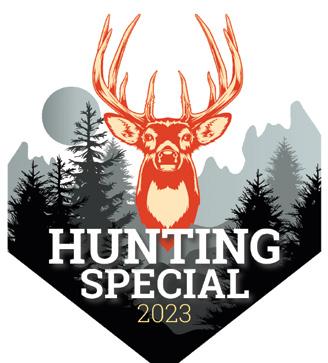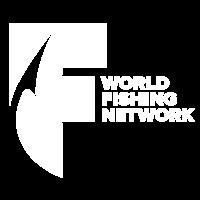
5 minute read
UP IN THEAIR
A primer on the challenge and thrill of hunting upland birds, waterfowl and small game with trained birds of prey

Advertisement
A

The falcon climbs into the clear blue Saskatchewan sky as the falconer lets his dog out of his truck, sending it into the field to find the grouse that just landed in a small patch of cover. The dog quickly finds the birds’ scent and goes on point. The falconer looks skyward to locate the falcon, which is now more than 600 feet up and still climbing while circling above the dog.
After letting the falcon make one more loop, the falconer commands “flush” as the raptor passes over the dog. With that, the dog rushes in and seven sharp-tailed grouse rise into the air. The falcon folds her wings back and begins her stoop, or dive. Reaching a breathtaking speed of some 200 kilometres an hour, she intercepts a fleeing grouse and knocks it to the ground, leaving a trail of feathers in the air. The falcon then wings over and lands on her prize. This is the very moment the falconer has spent a year or more preparing for—a hunt with no weapons other than two living hunting partners, a falcon and a bird dog.
Many hunters and anglers aspire to level the playing field, upping the ante by taking their pursuits to the next level and making them more challenging. Hunters may restrict themselves by only using muzzleloaders or longbows, for example, while anglers may opt to only use light tackle or fly rods. Falconry takes it one step further by using a trained bird of prey as the means for taking game. Want to spread your wings and give falconry a try? Here’s an overview of what you need to know to get started.
The Birds Of Prey
Falconry is the sport of hunting wild quarry with birds of prey, or raptors, which includes falcons, hawks and eagles. It has been practised for many thousands of years, reaching its pinnacle in Medieval times when the aristocracy embraced the sport. Even now, falconry continues to enjoy a small community of devotees (see “The raptor ranks,” next page).
A raptor used for falconry is not a pet, but rather an important member of a hunting team that also includes the falconer and typically one or more dogs. Not all birds of prey are suitable for falconry, however; it depends on whether the raptor’s style of hunting and typical prey are compatible with the sport and the interests of the falconer.
For example, large falcons are ideal if the quarry is primarily waterfowl or upland game birds, as is the case on the Canadian prairies.

Smaller falcons, such as the merlin, are held in high esteem simply because of their dramatic pursuit flights, even when the quarry is only a small bird such as a sparrow or starling. Hawks and eagles are more suited to hunting mammalian prey such as rabbits and squirrels, which are often found in areas close to large urban centres. Then there’s the centuries-old practice of hunting foxes with golden eagles on the Asian steppes, which has been highlighted recently in several documentaries.
In many areas where permitted, wild raptors can be taken from the nest when they are young, or trapped during the fall migration, for use in falconry. However, more and more falconry birds are now produced through captive breeding. In the mid-1900s, for example, falconers developed techniques to breed peregrine falcons in captivity when their populations were threatened by pesticides. This included the production of hybrids among species, sometimes providing falconers with birds specifically suited to their needs.
Today, in fact, many falconers prefer to fly hybrids between peregrines and gyrfalcons. That’s because the peregrine is noted for its tendency to “wait on,” circling high above its intended quarry, then providing a spectacular, highspeed stoop. The gyrfalcon, meanwhile, provides the size (it is the largest of the falcons) and the hardiness of an Arctic resident, which helps when the temperatures drop below -20°C on the prairies.
The Prey
In the flat lands of western
Canada, ducks and geese are the most common prey hunted with large falcons, with the abundance of small ponds most years providing ample opportunities. The most challenging of all western Canadian prey species is the sharptailed grouse, a formidable quarry for falcons. Sharpies are big, strong, fast birds, yet still highly manoeuvrable. They have the ability, unlike the pheasant, to fly long distances, and if your falcon is not in great shape, it won’t keep up. Some hunters might be surprised by the way sharptails respond when being attacked by an avian predator, compared with their rather slow flap-and-glide response to being flushed under the gun.
As for eastern Canada with its more forested regions, it sees more falconers using birds such as red-tailed hawks and goshawks to pursue rabbits and squirrels.
THE SET-UP
Hunting with trained raptors entails much more skill and effort than hunting with a firearm, which can be cleaned and stowed away until the next season rolls around. Falconry birds require a suitable enclosure » with perches, and they must be fed and cared for daily. For most forms of falconry, an appropriate dog is generally also a necessity for success. As with the bird, it needs to be cared for throughout the year, too, complete with countless hours of training and conditioning.

Specialized equipment, often made by falconers themselves, is also required. This includes leather hoods for the birds,
The Raptor Ranks
gloves (or gauntlets) for the falconer, leashes, lures for training, and so on. Modern falconry also now includes the use of kites and drones for training, and radiotelemetry technology for locating lost birds. Most recently, falconers have
FALCONRY IS PROBABLY the most highly regulated hunting sport in the world. Here in Canada, birds of prey come under the jurisdictions of the individual provinces and territories, each with its own set of regulations that may differ considerably. All birds of prey used in the sport, however, must have a special permit and leg band issued by the respective provincial or territorial wildlife department.
Owing to the varying regulations across jurisdictions, most provinces and territories have their own falconry clubs or associations. The Saskatchewan Falconry Association (SFA) is the oldest falconry group still in existence in North America. It was founded in 1958 by the late Richard Fyfe, a Canadian Wildlife Services biologist, and a handful of would-be falconers. The association’s membership has always remained small, with never more than 20 active members at one time.
Now a branch chapter of the Saskatchewan Wildlife Federation, the SFA has been involved with conservation efforts for decades, starting with the successful fight to attain legal protection for birds of prey in the 1960s. The group has also long been involved in digging nest holes for prairie falcons; banding records indicate more than 1,200 prairie falcons been using GPS transmitters connected to a smartphone app for tracking the location of their birds in real time. This has resulted in far fewer lost birds.

A common misconception is that a trained raptor can catch a bird with ease, then bring it back to the falconer. In reality, however, regular success is difficult to achieve, and the birds do not deliver their catch to the falconer. Instead, the falconer must typically search for the raptor and its downed quarry, often with the help of radio telemetry if the kill took place far away.
Whatever the case, nothing beats the feeling when it all comes together—with the falconer, dog and raptor working as one. OC have fledged from these artificial holes to date.
Also significantly, the SFA became involved in the captive-breeding and reintroduction of peregrine falcons when this magnificent bird was classified as endangered due to pesticides such as DDT. In 1976, the Saskatchewan Cooperative Falcon Project was formed as a consortium of the SFA, the Western College of Veterinary Medicine and the then provincial game department. Its main focus was the construction of a breeding facility, where more than 500 peregrines were produced for release and sent to sites in the U.S. Midwest and Canada. Members of the SFA were also politically active and played an important role on the Canadian Peregrine Falcon Recovery Team.
Today, the ongoing mission of the SFA is to improve and encourage competency in the ancient art of falconry among those who are prepared to make a commitment to the sport. Members must also commit to the conservation of birds of prey and the quarry they pursue, while promoting their value and role in nature.
















